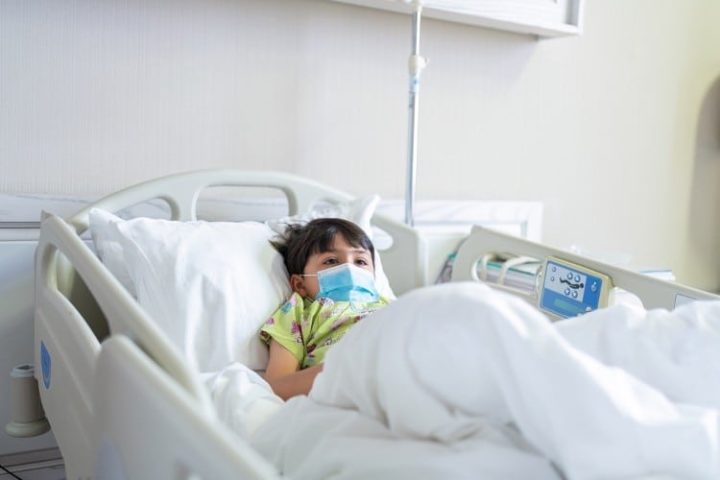
Sixty-seven percent of children aged five to 11 hospitalized during the Omicron surge had one or more underlying health conditions, such as diabetes, obesity, and neurological disorders, revealed the U.S. Centers for Disease Control and Prevention (CDC). Not a single child died. In total, 397 children were hospitalized during the Omicron outbreak.
In its Morbidity and Mortality Weekly Report released on Tuesday, the nation’s top healthcare agency wrote, “COVID-19 can cause severe illness in children.” Yet the data published in the report showed that “thirty percent of hospitalized children had no underlying medical conditions, and 19% were admitted to an intensive care unit.” Fifteen percent of those admitted to the ICU had no underlying medical conditions. Five percent of children were put on a ventilator.
“Children with diabetes and obesity were more likely to experience severe COVID-19,” said the report, adding, “Of the hospitalized children, 67% had one or more underlying medical conditions.”
The report compared hospitalization rates in children in stages when different strains of Covid dominated. It found that fewer children had to go to the hospital with Omicron than with Delta.
The researchers wrote, “the Omicron-predominant peak (2.8 per 100,000 children) was 2.3 times the Delta-predominant peak (1.2)” and, “consistent with other studies, this analysis demonstrated that the Omicron-predominant period was associated with less severe disease among hospitalized children.”
The underlying neurological conditions do seem to make Covid outcomes worse for children.
“One third of hospitalized children aged 5–11 years had underlying neurologic disorders during the Omicron-predominant period, an increase from previous periods. Neurologic disorders have been shown to increase risk for severe illness in other respiratory diseases such as influenza,” noted the authors.
At the same time, other comorbidities, such as asthma and immunocompromising conditions, were not associated with increased risk of severe Covid outcomes.
The CDC further admits that “a higher proportion of children hospitalized with laboratory-confirmed SARS-CoV-2 infection were admitted for reasons that were not likely primarily COVID-19–related during the Omicron period compared with the Delta period.” Yet, it continued by stating that “most children admitted during both periods were hospitalized primarily for COVID-19.” The agency did not break down the reasons for hospital admissions of children with confirmed Covid infections.
The median hospital stay time for children hospitalized with a positive Covid test remained the same as the Delta period — 3 days — and was slightly lower than pre-Delta.
While the agency stressed that “Potential for serious disease requiring hospitalization, ICU admission, or IMV among children aged 5–11 years reinforces the importance of increasing vaccination coverage among this population,” it observed in the same report that there were “no significant differences for severe outcomes by vaccination status.” It was also noted that the sample size of “vaccinated children was small.”
It found that “the cumulative hospitalization rate during the Omicron-predominant period was 2.1 times as high among unvaccinated children (19.1 per 100,000 population) as among vaccinated children (9.2).”
Therefore, the agency concluded that “all eligible children” should be protected from Covid by keeping their vaccination status “up-to-date.” The CDC currently recommends children as young as 12 and older get a booster shot, or a third vaccine dose.
What report from the CDC would come without stressing the importance of “equitable” vaccine coverage?
Because “black children accounted for the highest percentage of unvaccinated children in this analysis and represented one third of COVID-19–associated hospitalizations in this age group,” the agency believes that “increasing COVID-19 vaccination coverage among children aged 5–11 years, with particular attention to racial and ethnic minority groups disproportionately affected by COVID-19, is critical to reducing COVID-19–associated morbidity.”
It should be noted that the CDC only considered those children “vaccinated” who received both doses of the Covid vaccine prior to ending up in the hospital. Currently, Pfizer/BioNTech is the only vaccine available for the said age group and is administered in the United States under the Emergency Use Authorization (EUA), which means that the vaccine is considered “investigative,” or experimental.
Speaking scientifically, recommending all children get the COVID vaccine is unjustified in terms of both efficacy and safety.
The efficacy of the shot that was designed against the original strain of SARS-CoV-2 offers little protection against Omicron, which has already mutated into two subvariants.
A major study published at the end of February by the New York State Department of Health found that “There is limited evidence on the effectiveness of the BNT162b2 vaccine for children, particularly those 5-11 years old and after the Omicron variant’s emergence.”
According to research, from December 13, 2021 to January 30, 2022, the effectiveness against infection for children in that age group fell from 68 to only 12 percent. During the same time period, hospitalization protection fell from 100 percent to 48 percent.
As for the safety of the shots, top non-establishment doctors argue that the known and potential risks of the shots to children’s immune, reproductive, neurological, and cardiovascular systems far outweigh the benefits. Therefore, no healthy child should be recommended to take the shot.
The CDC is not being transparent about the shots’ safety and efficacy, and it has been criticized for its handling of Covid-related data. In March, for example, it was revealed that the agency overcounted pediatric COVID deaths by 25 percent. The data has been used to justify the vaccine’s rollout for children.





